Solved problems
1.1. How to determine the density of a magnet
Needed materials:
3 natural magnets of different sizes, scales or scales, water in a graduated cylinder, ruler, graph paper (math sheet).
Experiment description:
- Weigh each magnet in turn to determine its mass.
- Measure the volume of each magnet with the graduated cylinder.
- Fill in the data in the following table and process it.
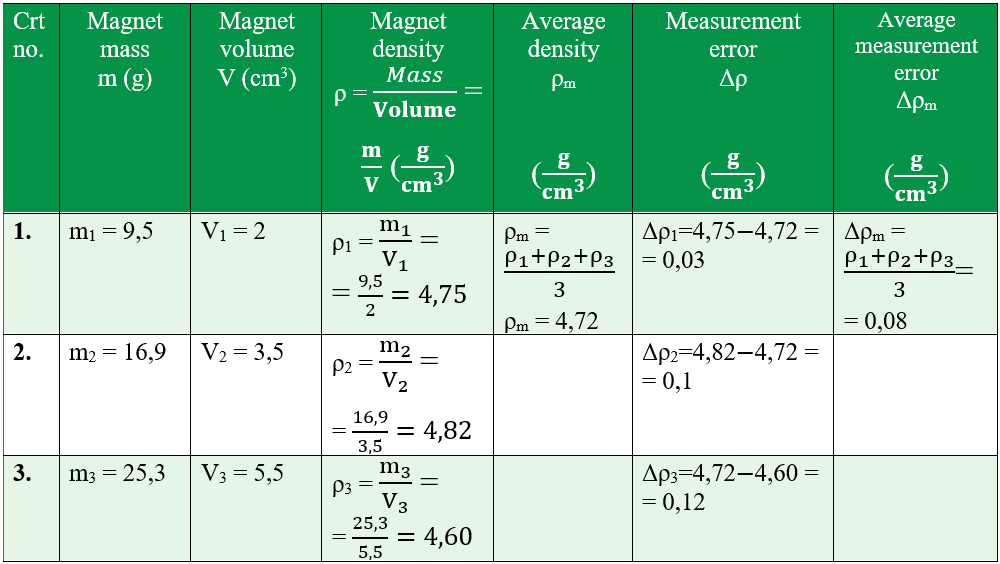
- Gives the result of the measurement:

- Graph the body mass according to its volume. You will get a straight line. If you choose an arbitrary point on the right, you will find the body mass at a certain volume. For example for the red dot: we have m = 18,5 g and V = 4 cm3 .
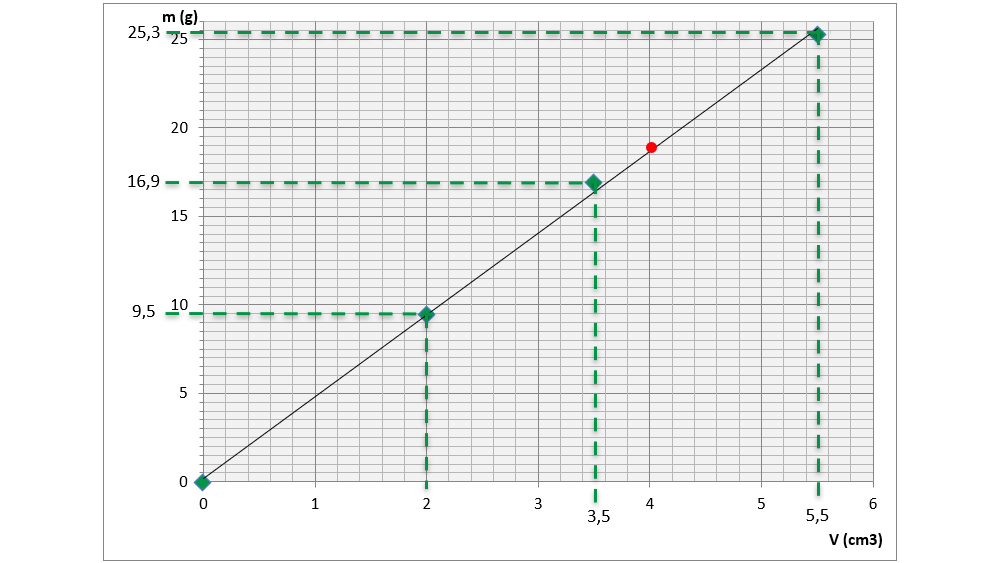
What do you notice?
For a certain substance, the higher its mass, the higher its volume.
Experiment conclusion: Density is a constant for a particular substance, being equal to the ratio of mass to body volume.
Needed materials:
Ruler, graph paper (math sheet).
Experiment description:
- Draw three right triangles of different sizes on the graph paper.
- Measure, for each, the length of the hypotenuse (the side opposite the right angle) and the two legs (catheti).
- Fill in the data in the following table and process it.

What do you notice?
The more the hypotenuse squared, the more the sum of the squares of the legs (catheti) increases.
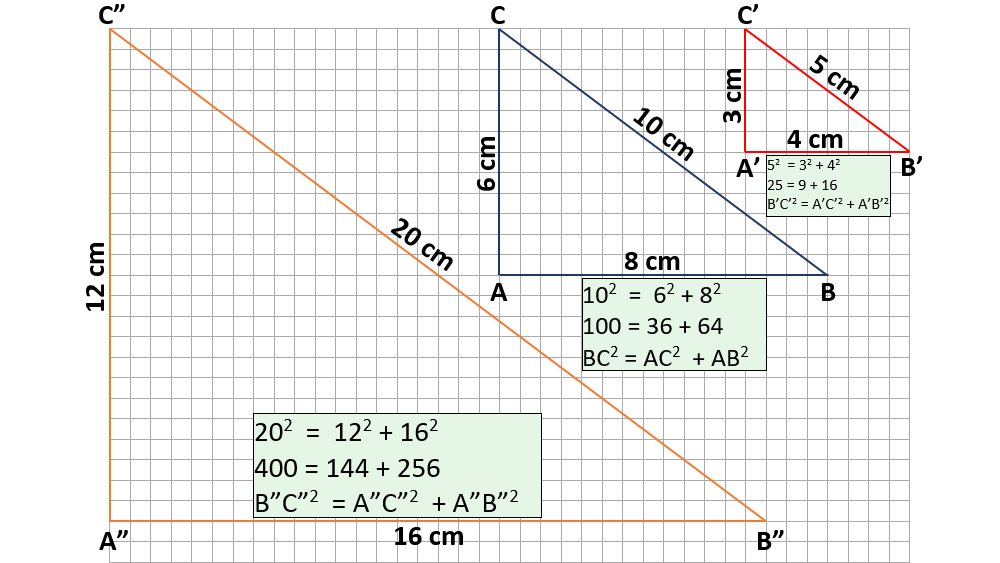
Experiment conclusion:
- In a right-angle triangle, the square of the hypotenuse is equal to the sum of the squares of the two legs (catheti).
1.3. Graph the following vectors:
1.3.A. A traveler travels 10 km on a straight road to the east.
Solution:
d = 10 km, horizontal direction, to the right.
Standard: 1 cm : 2 km
To put the point of application we need to see the vector way. This is to the right, we will put 0 to the left of the page.
To find the length of the vector segment we divide the value (modulus) of the vector to the value of the standard: 10 : 2 = 5cm.
We draw a 5 cm segment horizontally and at the top we put the arrow that shows its way. Next to the arrow we note the vector.

1.3.B. A body is thrown at a speed of 120 km / h, vertically, downwards.
Solution:
So v = 120 km / h, vertical direction, downward way.
Standard: 1 cm : 40 km/h
To put the point of application we need to see the vector way. This being down, we will put 0 at the top of the page.
To find the length of the vector segment we divide the value (modulus) of the vector to the value of the standard: 120 : 40 = 3 cm.
Desenăm un segment de 3 cm pe verticală și în vârf îi punem săgeata care arată sensul lui. Lângă săgeată notăm vectorul.
We draw a 3 cm segment vertically and at the top we put the arrow that shows its way. Next to the arrow we note the vector.

1.3.C. A force of 1800 N acts on a body, in a direction that makes an angle of 50 ° with the vertical, upwards.
Solution:
So F = 1800 N, direction with an angle of 50 ° with the vertical, upward way.
Standard: 1 cm : 300 N
To put the point of application we need to see the vector way. This being up, we will put 0 at the bottom of the page.
To find the length of the vector segment we divide the value (modulus) of the vector to the value of the standard: 1800 : 300 = 6 cm.
Point the main direction, put the line of the protractor on it, with its middle in 0 and measure the angle of 50° with the vertical. In this oblique direction we draw a 6 cm segment and at the top we put the arrow that shows its way. Next to the arrow we note the vector.
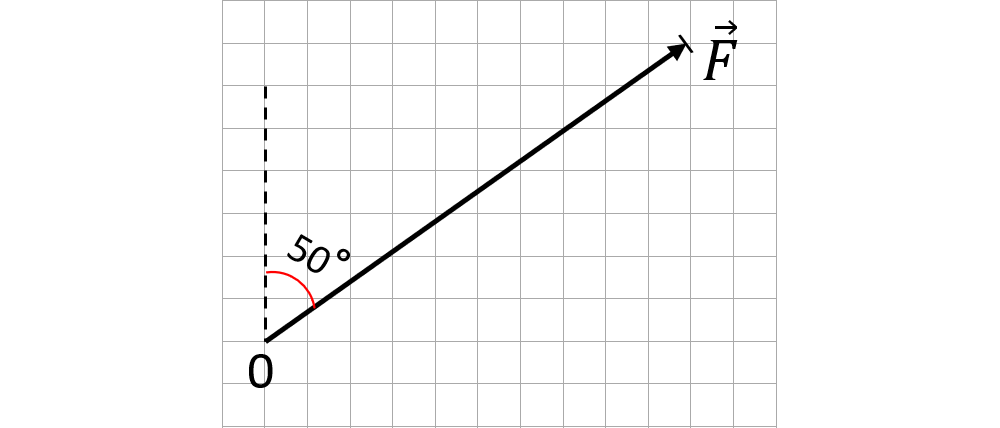
1.3.D. A body moves accelerated with an acceleration of 42 m/s2, in a direction that makes an angle of 30° with the horizontal, upwards.
Solution:
So, a = 42 m/s2, in a direction that makes an angle of 30° with the horizontal, upwards.
Standard: 1cm : 6 m/s2
To put the point of application we need to see the vector way. This being up, we will put 0 at the bottom of the page.
To find the length of the vector segment we divide the value (modulus) of the vector to the value of the standard: 42 : 6 = 7 cm.
Dotted the main direction, put the line of the protractor on it, with its middle in 0 and measure the angle of 30° with the horizontal. In this oblique direction we draw a 7 cm segment and at the top we put the arrow that shows its way. Next to the arrow we note the vector.

1.4. Which of the following physical parameters are scalar or vector, respectively?
- Area (S) - scalar
- Time (t) - scalar
- Acceleration (a) - vector
- Friction force (Ff) - vector
- Temperature (T) - scalar
- Weight force (G) - vector
- Movement (d) - vector
1.5. Two children pull a sledge on a horizontal road, to the west, with the forces F1 = 400 N, respectively F2 = 800 N. Compose the two forces of children.
Solution:
The resulting vector has:
- numerical value equal to the sum of the numerical values of the component vectors, ie F = F1 + F2 = 400 N + 800 N = 1200 N.
- direction common with component vectors: horizontal.
- way common with component vectors: to the left.
To represent the resulting vector we must choose an appropriate standard so that we have enough place for the drawing on the notebook page.
Standard: 1 cm: 200 N
The resulting vector segment is 1200 : 200 = 6 cm.

1.6. Two forces act on the spring of a dynamometer suspended from a support, one of 60 N, vertically downwards, the other of 150 N, vertically upwards. What force does the dynamometer indicate?
Solution:
The resulting vector has:
- numerical value equal to the difference of the numerical values of the component vectors, ie F = F2 - F1 = 150 N - 60 N = 90 N.
- direction common with component vectors: vertical.
- way of the higher value vector: up.
To represent the resulting vector we must choose an appropriate standard so that we have enough place for the drawing on the notebook page.
Standard: 1 cm: 30 N.
The resulting vector segment is 90:30 = 3 cm.

1.7. Two forces act on a dynamometer, one of 150 N in a vertical direction, upward direction. The dynamometer indicates a force of 90 N, its spring being elongated vertically downwards. Draw the second force acting on the dynamometer spring.
Solution:
Standard: 1 cm : 60 N.
We write the vectorial equation:

We write the scalar equation taking into account the sign convention:
-90 N = 150 N + F2 (F is taken with minus, because it is vertically down, and F1 is taken with plus, because it is vertically up)
F2 = -90 N -150 N = -240 N. It turns out that F2 has a segment of 240 : 60 = 4 cm, in a vertical direction, the downward way (because it gave us the minus sign).
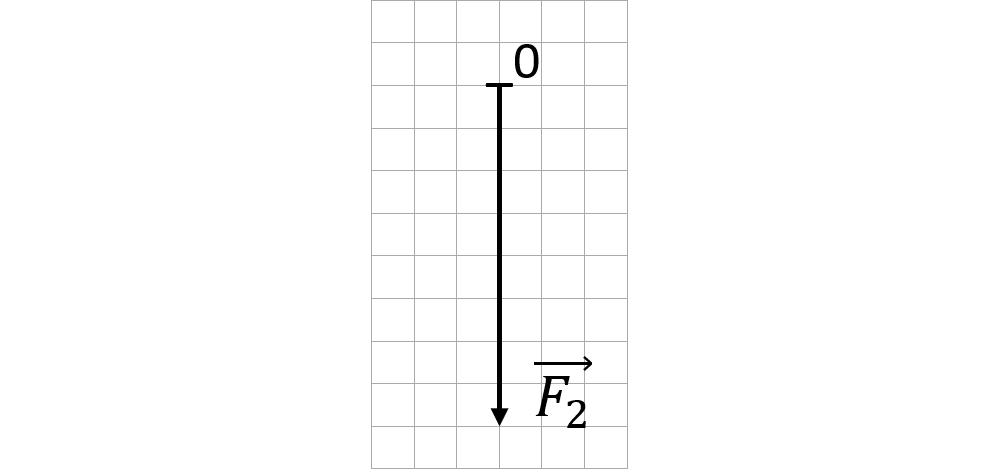
1.8. A river flows east at a speed of 60 km/h. A boat goes on the river in its direction of flow at a speed of 100 km/h, in a direction that makes an angle of 30° to the river bank. What is the speed of the boat towards the shore? Graphs using the following scale: 1 cm: 20 km/h.
Solution:
v1 = 60 km/h, horizontal direction, to the right
v2 = 100 km/h, direction that makes an angle of 30° with the horizontal, upwards.
Standard: 1cm : 20 km/h.
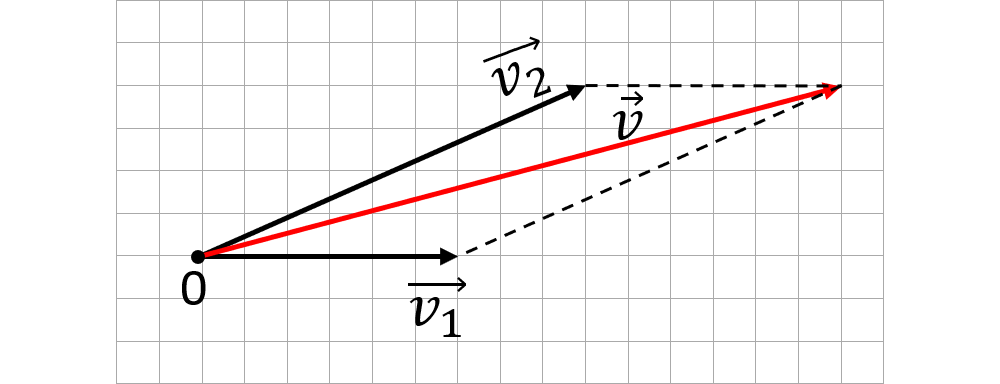
1.9. A cyclist goes 20 km East, then 40 km South, then 80 km West and 60 km North. Determine the resulting vector, ie how far the cyclist is compared with th initial point of departure (0).
Solution:
d1 = 20 km, horizontal direction, to the right
d2 = 40 km, vertical direction, down
d3 = 80 km, horizontal direction, to the left
d4 = 60 km, vertical direction, upwards

Standard: 1 cm : 10 km.
-
We represent the first movement vector d1. We put the second vector at the top of the first vector, and so on, until we represent all four vectors.
-
The resulting vector is the segment obtained by joining the origin (0) with the vertex of the last vector. The resulting vector has the same vertex as the last vector vertex.
-
The value of the resulting vector is obtained by measuring its segment with the ruler and then multiplying by the given standard: d = 6,3 ∙ 10 = 63 km. So the cyclist is at a distance of 63 km from the starting point, after the whole race.
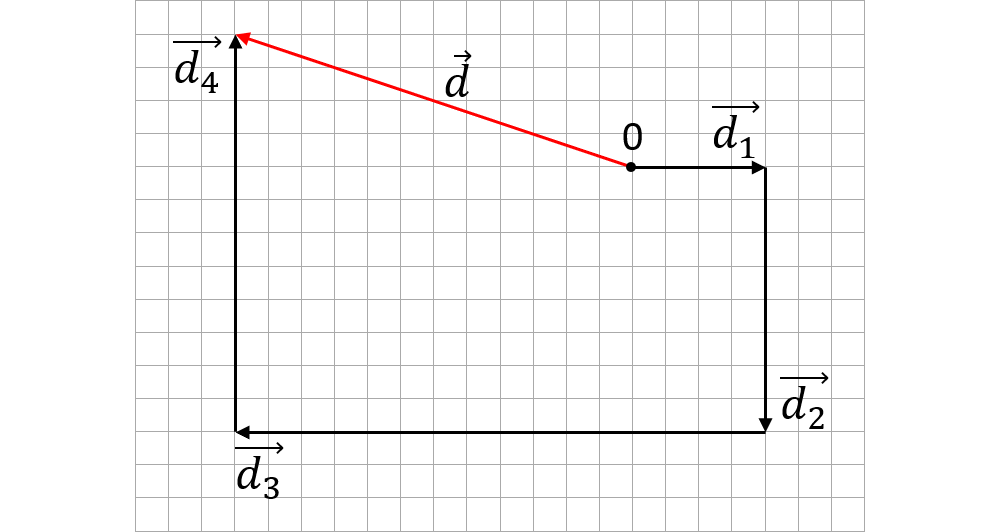
1.10. Laurence strikes a nail with a hammer with a force of 500 N in a wall, holding the nail inclined towards the wall with an angle α = 38°. What is the value of the forces that compose Laurence's force?
Solution:
F = 500 N, direction that makes an angle of 38° with the vertical.
We can find out the two forces by the graphical method.
Standard: 1 cm : 100 N
500 N : 100 N = 5 cm represents the segment of the force F and we draw it.
From the top of the vector F they go perpendicular to the two directions Ox and Oy.
We measure the segments of the component vectors with the ruler and we multiply with the standard to find out their values.
Fx = 3 ∙ 100 = 300 N
Fy = 4 ∙ 100 = 400 N
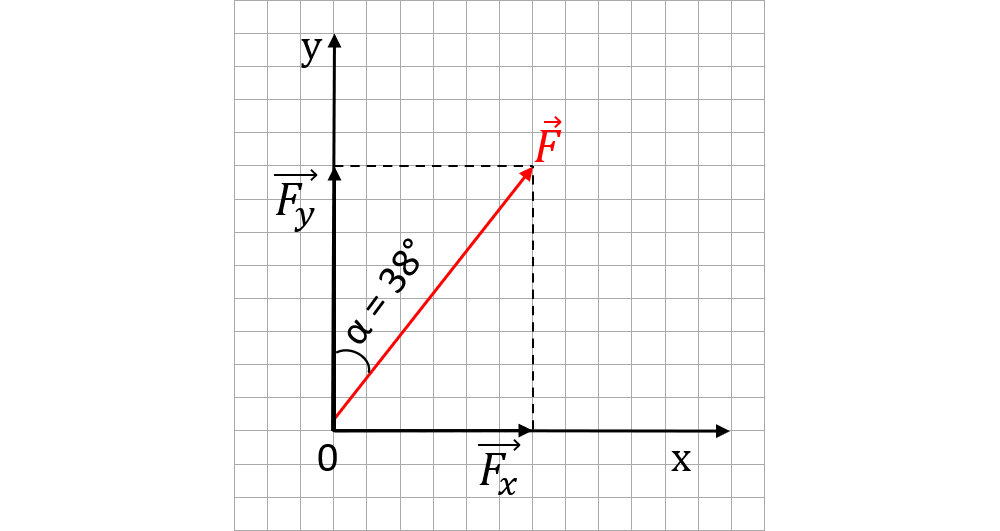
We write the vectorial equation:

We check with Pythagoras' theorem
We write the scalar equation:

5002 = 3002 + 4002
250000 = 90000 + 160000